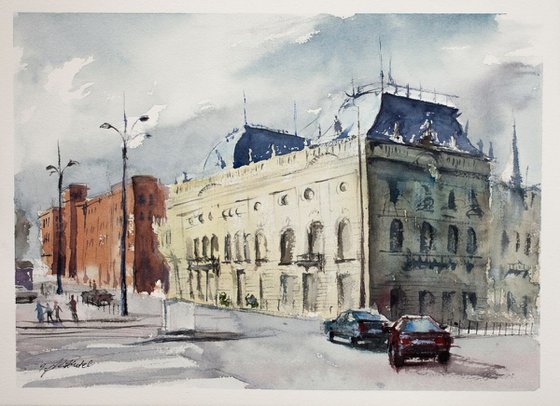- By medium
- By subject
- By budget
- Sales
- Gift cards
- Discover all art
- Artists
- Editors’ picks
- Ideas
Original artwork description:
I miss my hometown I guess this is why this painting has created. Beautiful Palace in the city center. Must see place in Lodz (Poland). Painted on 11×15 Saunders Waterford Paper 300 gsm.
About Palace (source Wikipedia)
The history of the palace goes back to the 1860s. It was during this time that Kalman Poznański, a Polish-Jewish trader from Kowal in the Kuyavia region, arrived and began to live in Łódź. Kalman started a cotton industry, however, it was not successful. But when the business was taken over by his son Izrael Kalmanowicz (1834-1900), there was a phenomenal rise in the price of cotton around the world. Izrael made a fortune from cotton and spent a large part of his earnings on the palace, which eventually took on his name.[2]
When Izrael Kalmanowicz acquired the site of the palace there was a modest two-story building standing already. He renovated and expanded the building into a large residence. The palace was marked for its lavishness and grand size, an anomaly from the neighboring simple residences.
The palace's design was originally thought to be that of Adolf Seligson. More recently, however, J. Jung and D. Rosenthal have been identified as the architects. Whoever the architect, the palace is an impressive feat, most notably because of its L-shaped design. There was also a large garden at the back. Another feature of the palace is the southern wing, which is topped with the tall domed roofs.
Materials used:
11×15″ Saunders Waterford Paper 300 gsm & Winsor and Newton paints
Tags:
#watercolour architecture #lodz #izrael poznański palace #cityscape #israel #city street #polandIzrael Poznanski Palace (2017) Watercolour
by Tomasz Mikutel
7 Artist Reviews
£80 Sold
- Watercolour on Paper
- One of a kind artwork
- Size: 38.1 x 27.94 x 0.25cm (unframed) / 35.56 x 25.4cm (actual image size)
- Signed on the front
- Style: Impressionistic
- Subject: Architecture and cityscapes
Loading
Original artwork description
I miss my hometown I guess this is why this painting has created. Beautiful Palace in the city center. Must see place in Lodz (Poland). Painted on 11×15 Saunders Waterford Paper 300 gsm.
About Palace (source Wikipedia)
The history of the palace goes back to the 1860s. It was during this time that Kalman Poznański, a Polish-Jewish trader from Kowal in the Kuyavia region, arrived and began to live in Łódź. Kalman started a cotton industry, however, it was not successful. But when the business was taken over by his son Izrael Kalmanowicz (1834-1900), there was a phenomenal rise in the price of cotton around the world. Izrael made a fortune from cotton and spent a large part of his earnings on the palace, which eventually took on his name.[2]
When Izrael Kalmanowicz acquired the site of the palace there was a modest two-story building standing already. He renovated and expanded the building into a large residence. The palace was marked for its lavishness and grand size, an anomaly from the neighboring simple residences.
The palace's design was originally thought to be that of Adolf Seligson. More recently, however, J. Jung and D. Rosenthal have been identified as the architects. Whoever the architect, the palace is an impressive feat, most notably because of its L-shaped design. There was also a large garden at the back. Another feature of the palace is the southern wing, which is topped with the tall domed roofs.
Materials used:
11×15″ Saunders Waterford Paper 300 gsm & Winsor and Newton paints
Tags:
#watercolour architecture #lodz #izrael poznański palace #cityscape #israel #city street #poland14 day money back guaranteeLearn more

